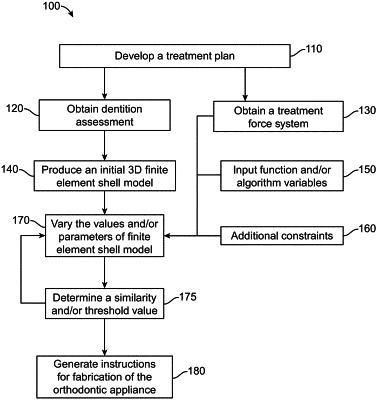| CPC A61C 7/002 (2013.01) [A61C 7/08 (2013.01)] | 22 Claims |

|
1. A method for designing an aligner, the method comprising:
identifying an intended outcome of a dentition of a patient at an end of at least one stage of a treatment plan to treat the dentition;
identifying one or more forces implemented on the dentition during the at least one stage of the treatment plan;
identifying one or more clinical acceptability criteria for the at least one stage, the one or more clinical acceptability criteria providing criteria to evaluate compliance with the intended outcome;
generating an aligner model representing an aligner configured to be worn on the dentition during the at least one stage to treat the dentition;
providing a thickness map of the aligner model, wherein the thickness map comprises a thickness parameter for each location of the aligner model, and wherein each thickness parameter is initially set to a starting thickness;
reducing the value of each thickness parameter of the thickness map over a plurality of iterations until a resulting thickness is determined for each thickness parameter, wherein:
the resulting thickness of each thickness parameter is less than the corresponding starting thickness of each thickness parameter,
the resulting thickness is determined based on the one or more forces and a plurality of new models for the aligner model, wherein each new model is generated using a corresponding iteratively reduced thickness value for each iteration of the plurality of iterations, and
the resulting thickness is associated with a satisfactory outcome of the dentition at the end of the at least one stage, the satisfactory outcome satisfying the one or more clinical acceptability criteria; and
providing instructions to manufacture the aligner using the aligner model with the resulting thickness determined for each thickness parameter of the thickness map.
|